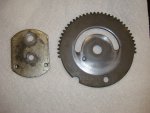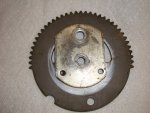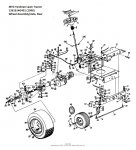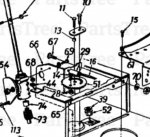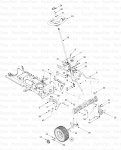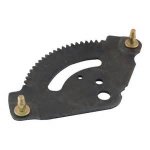Ronno6
Lawn Addict
- Joined
- Apr 8, 2016
- Threads
- 24
- Messages
- 1,933
I am working on my Huskee (MTD) 148AR808K731 w/54" deck.
The steering is very sloppy.
I have replaced the tie rod ends,plastic bushings, steering shaft pinion bushing and the pinion.
Last season I replaced one of the bronze flange bushings that the steering gear rides on (the guide
bushing that rides in the arc shaped slot.)
I did not replace the front flange bushing in the steering gear.
I have also replaced the wheel bushings, but wobble still remains. Looks like time for new spindles.....
The steering gear, a more or less flat plate with teeth on the edge that the pinion gear meshes with is very wobbly/sloppy.
Is it this way by design?
There is a gap between the steering gear plate and the steering support bracket.
This permits considerable flop of the steering gear.
Is there any way to tighten this up?
A sheet of plastic between the steering gear and the support bracket?
If so, is it advisable?
The steering linkages are also sloppy on the plastic bushings.
Can these be tightened up?
They contact the plastic bushings at an angle. The linkage ends could be bent to be parallel with the steering gear
and a metal flange bushing installed, but would this be a problem when the front axle has to pivot with the terrain?
So, is it advisable??
Thanks in advance.
The steering is very sloppy.
I have replaced the tie rod ends,plastic bushings, steering shaft pinion bushing and the pinion.
Last season I replaced one of the bronze flange bushings that the steering gear rides on (the guide
bushing that rides in the arc shaped slot.)
I did not replace the front flange bushing in the steering gear.
I have also replaced the wheel bushings, but wobble still remains. Looks like time for new spindles.....
The steering gear, a more or less flat plate with teeth on the edge that the pinion gear meshes with is very wobbly/sloppy.
Is it this way by design?
There is a gap between the steering gear plate and the steering support bracket.
This permits considerable flop of the steering gear.
Is there any way to tighten this up?
A sheet of plastic between the steering gear and the support bracket?
If so, is it advisable?
The steering linkages are also sloppy on the plastic bushings.
Can these be tightened up?
They contact the plastic bushings at an angle. The linkage ends could be bent to be parallel with the steering gear
and a metal flange bushing installed, but would this be a problem when the front axle has to pivot with the terrain?
So, is it advisable??
Thanks in advance.

